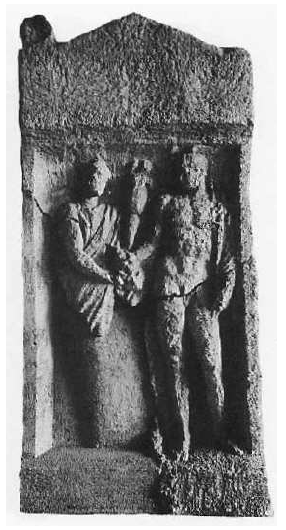d) Mercurius with a nameless female consort: Rosmerta?
It seems that many figurations without any inscription are attributed to Mercurius and Rosmerta without firm evidence.925 While Mercurius is easily recognizable by his petasus*, purse, caduceus* and typical animals,926 Rosmerta does not possess any attributes peculiar to her, but generic characters of fertility usually attributed to deities of abundance and prosperity, such as the Matres / Matronae and Classical figures, such as Maia, Fortuna, Venus, etc. While some goddesses can be distinguished in anepigraphic images by typical attributes of their own, such as Nantosuelta with her distinctive pole-house emblem and crow, Rosmerta cannot. Moreover, Mercurius is often partnered in the iconography with other goddesses, such as Maia and Fortuna or mother goddesses of plenty, who bear, like Rosmerta, mere attributes of fertility and abundance. Accordingly, on reliefs* without inscription, such as the ones from Autun (Saône-et-Loire), Auxerre (Yonne), Saint-Moré (Yonne) or Vertault (Côte d’Or),927 it is not possible to assert that the consort of Mercurius is Rosmerta. Similarly, the couple from Néris-les-Bains (Allier), often attested as being a representation of Mercurius and Rosmerta, are actually a figuration of Mercurius with a Nymph or Venus.928 By the same token, Green and Graham Webster both tall into this trap when they claim that Rosmerta was venerated in British water sanctuaries, such as in Bath and in Gloucester, for there is no evidence that the goddess accompanying the god Mercurius on the reliefs* is actually Rosmerta.929 Rosmerta is never attested in the epigraphy from Britain. Moreover, the goddess accompanying Mercurius in the British iconography is often attributed with a sort of small bucket or wooden tub, interpreted as a symbol of plenty, comparable to the cauldron of renewal.930 And Rosmerta is never associated with such an attribute on the Continent. Therefore, this goddess with a bucket should be understood as a different type.
It is nonetheless possible to identify anepigraphic reliefs* with Mercurius and Rosmerta when dedications to the couple were discovered in the same area. Thus, Colette Bémont, who has studied the various non-inscribed iconographical monuments possibly representing the couple, attributes the monuments from Niedaltdorf (Germany),931 Kirkelneuhäusel (Germany),932 Eisenberg (Germany),933 Metz (Moselle),934 Dijon (Côte d’Or), Autun (Saône-et-Loire) and Sens (Yonne - lost)935 to Mercurius and Rosmerta.936 In Niedaltdorf for instance, the inscription to the couple – given above - was found among the ruins of a small temple together with the fragments of a relief* representing Mercurius and a draped goddess. On account of the dedication, the goddess is undoubtedly Romserta.937 Similarly, a stele* found in Metz has Mercurius, naked, with petasus* and caduceus*, offering a purse to a goddess of plenty, who wears a long dress and a coat and holds a cornucopia* in her left hand (fig. 33). The portrayal is combined with an inscription mentioning Mercurius only: In h(onorem) d(omus) d(ivinae) De[o Mercur]io Iu[…], ‘In honour of the Divine House, to the god Mercurius [...]’.938 As the relief* was discovered in the same street as the inscription to Mercurius and Rosmerta, engraved on a socle of a statue, the figuration is certainly that of Mercurius and Rosmerta.939
Outside the ‘areas of inscriptions’, it is difficult to determine whether the images of Mercurius with a goddess are representation of Mercurius and Rosmerta. Bémont explains the impossibility - due to the lack and uncertainty of the iconographical evidence - to establish a distinction between Rosmerta and Maia in their attributes.940 The iconographical types she distinguishes are Maia-Rosmerta holding a basket of fruit or a cornucopia*, such as in Niedaltdorf or Kirkelneuhäusel, and Maia-Rosmerta bearing Mercurius’s attributes, such as the purse, for instance in Metz and Eisenberg, or the caduceus* and purse, for instance in Nöttingen and Schorndorf.941
